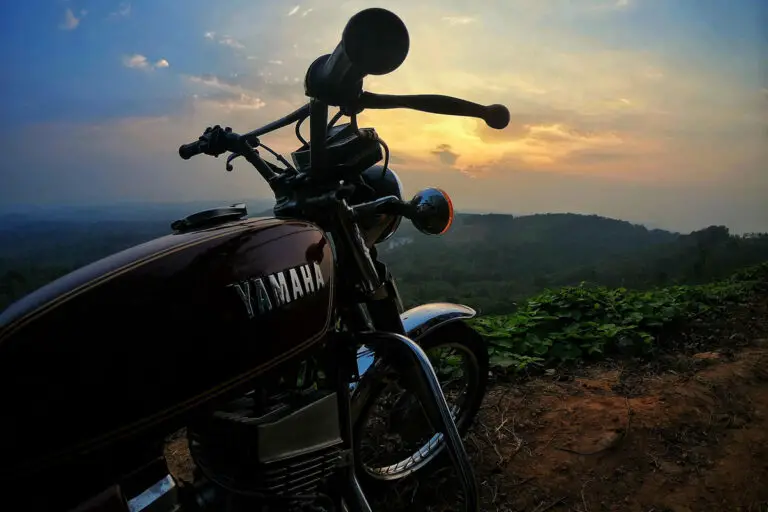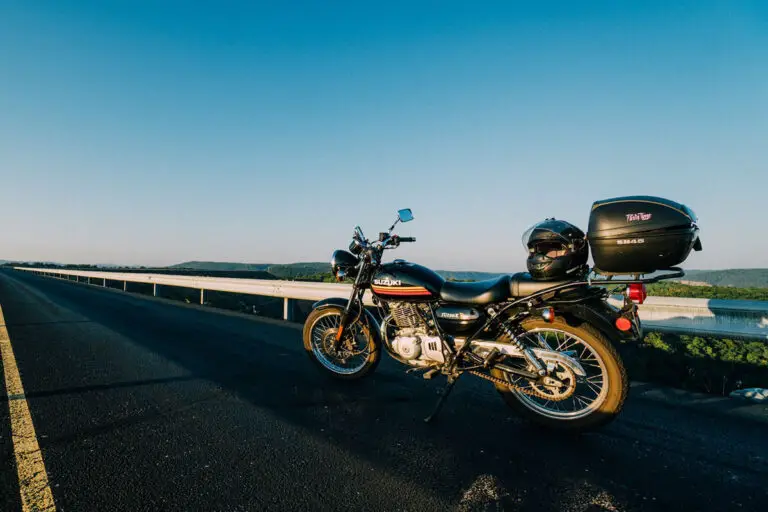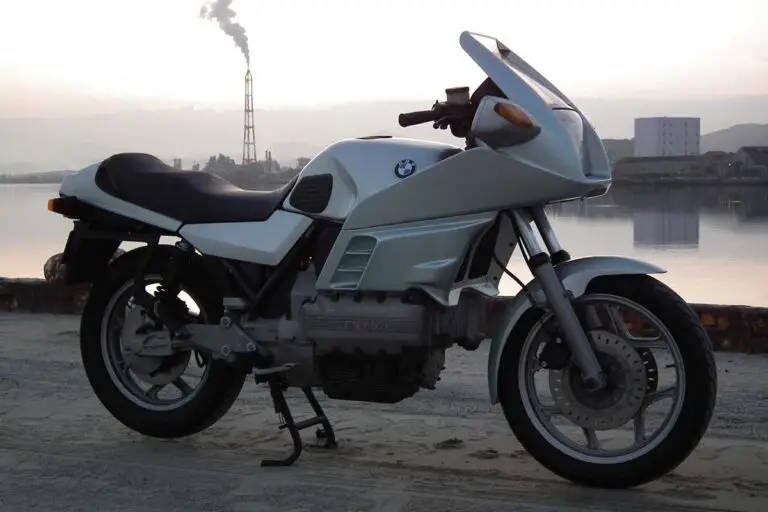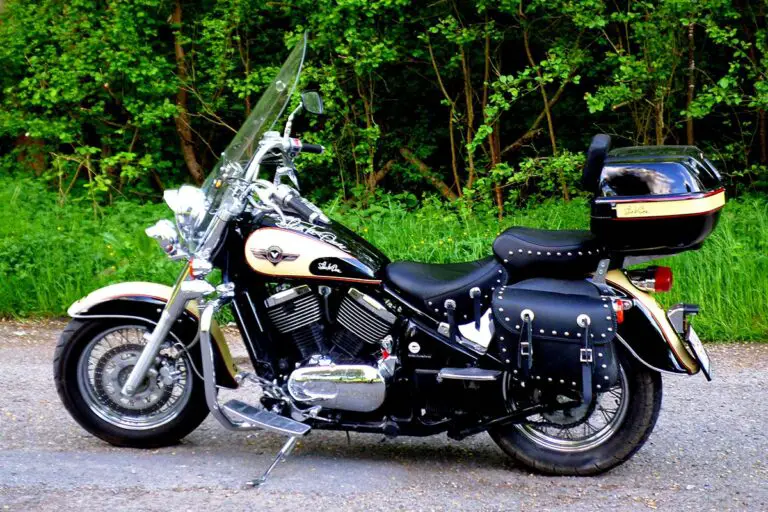Kawasaki Vulcan 1500 Specs & Review (Cruiser Bike)
Disclosure: We may get commissions for purchases made through links in this post.
In the 1987 May issue of Popular Mechanics, Norman Mayersohn referred to the Kawasaki Vulcan 1500 as “Kawasaki’s King Cruiser.” And at the time, it truly was – not only for the Japanese firm but also for the entire segment. The industry may not have anticipated it, but the Indian-inspired cruiser beat the royalty Harley-Davidson in power and style.
The Kawasaki Vulcan 1500 is a cruiser motorcycle produced by Kawasaki from 1987 to 2008. Recognized as “the King of custom cruiser bikes,” the two-wheeler looked every part a road-ready bobber out of the crate – with its monstrous engine, 120-mph top speed, and flashy exterior.
Familiarity with current superstars such as the Royal Enfield Meteor and Team Green’s very own Vulcan S entails an understanding of the big-bore classics. Continue reading this article and learn more about the history, specifications, and other interesting facts about the Kawasaki Vulcan 1500.

Rediscovering the Kawasaki Vulcan 1500
The Kawasaki Vulcan 1500 is 3rd in the line of Vulcan motorcycles and the 4th largest displacement from the said series. Launched in 1987, this icon immediately earned the moniker “King of Custom Cruiser Bikes” for its retro styling, massive power, and engine displacement that finally beat the reigning 1,340-cc Harley-Davidson Evolution motorcycles.
Besting Milwaukee’s real-steel machines was no easy feat. To achieve this, Kawasaki had to forego simplicity and go the route of practicality with a ton of dazzle. That meant the ’87 model was at the receiving end of impeccable bodywork, hydraulic valve adjustment, and advanced tech on top of impressive road performance (to name a few).
While these qualities may not have converted bike purists, they were enough for consumers to deem the bike a formidable contender that kept Harley-Davidson on its toes. More importantly, this masterpiece added to the list of prototypes that greatly influenced the plethora of present-day highway-ripping wheelers.
Kawasaki Vulcan 1500 Specs & Features
Engine
The Kawasaki Vulcan 1500 models split into two groups based on engine configuration. The carbureted models consisting of earlier Classic, Tourer, and Nomad trims had a single Keihin CVK40 carb that handles air-fuel mixture. Meanwhile, FI trims had 36-mm V-twin engines (later upgraded to 38 mm) coupled with an in-tank friction pump and 0.3-mm (0.012-inch) diameter fuel injectors.
A liquid-cooling system complements these 4-stroke SOHC powerplants. The bike has a bore-stroke ratio of 102 × 90 mm (4.02 × 3.54 inches). Engine displacement is 1,470 cm³ (89.7 in³), while compression ratio is 8.6:1 (carbureted)/9.0:1 (fuel-injected). With FI models, the upgraded compression ratio meant cleaner fuel burn and improved power delivery versus better mileage.
Overall, engine configuration lends to a top speed of 107 mph (172 km/h), a maximum horsepower of 64-65 hp/47-48 kW @ 4,700 RPM, and a torque output of 113-114 Nm (11.5-11.6 kgf-m) @ 2,800-3,800 RPM. Most trims share these performance figures. The Mean Streak, however, has an exceptional speed rating of 120 mph (193 km/h) and 72 hp (53 kW) @ 5,500 RPM horsepower compared to the rest of the Vulcan models.
Fuel & Lubrication
Fuel tank capacity is 19 liters (5.02 US gal) of unleaded gasoline with a minimum PON 87/RON 91 rating. Fuel-injected trims require higher-octane fuel (at least PON 90) – hence, it would be best to consult the service manual for specifics. Tank capacity was enhanced beginning with the Classic FI. But due to the introduction of DFI, this also meant non-improvement in the bike’s combined fuel economy of 42.8 mpg (5.5 L/100 km) despite the 3-liter difference in fuel capacity.
Lubrication-wise, the Vulcan has a Forced lubrication (wet sump) system and requires between 2.9 liters (3.1 US quarts) and 3.5 liters (3.7 US quarts) of K-Tech engine oil or its equivalent. The recommended oil is SAE 10W-40 with a minimum API grade of SJ or SL meeting JASO T903 MA standards. You may opt for other viscosity grades following ambient temperature.
Drivetrain
The Kawasaki Vulcan 1500 had either a 4- or 5-speed manual (wide-ratio) constant mesh return system and a wet, multi-disc clutch assembly, depending on model year and trim. A Cardan shaft drive handles power delivered to the wheels. The powertrain is paired with a digital-memory-type ECU and gear-driven counterbalancers, making for a silky-smooth riding experience.
For reference, the stock gear ratios are below:
| Primary Reduction Ratio | 1.517 (85/56) |
| Transmission Gear Ratio (1st) | 2.500 (40/16) |
| Transmission Gear Ratio (2nd) | 1.590 (35/22); 1.375 (VN1500D1-D2) |
| Transmission Gear Ratio (3rd) | 1.192 (31/26); 1.035 (VN1500D1-D2) |
| Transmission Gear Ratio (4th) | 0.965 (28/29); 0.781 (VN1500D1-D2) |
| Transmission Gear Ratio (5th) | 0.781 (25/32) |
| Final Reduction Ratio | 2.619 (15/21 × 33/9) |
| Overall Drive Ratio | 3.105 @ top gear |
Ignition
A battery and coil (transistorized) ignition and electric starting system bring the two-wheeler, electronic speedometer, and other accessories to life. The charging system is a triple-phase A.C. alternator with a delta connection and twin magnet rotors. It has a rated output of 64-96V @ 3,000 RPM. Ignition timing is 5° BTDC @ 950 RPM (initial “F” mark) and 25° BTDC @4,500 RPM (full advance).
Carbureted bikes have 12V 14Ah/(10 HR) batteries, while fuel-injected ones are fitted with a 12V 18 Ah/(10 HR) FTZ16-BS battery. This particular battery is no longer manufactured but is replaceable with a YTX20CH-BS battery (view on Amazon) format with dimensions of 150 x 87 x 161 mm (6.00 x 3.44 x 6.38 inches – L x W x H). Additionally, all models require an NGK DPR6EA-9 or Nippon Denso X20EPR-U9 spark plug with a 0.031 – 0.035 inch gap and torque spec of 18 Nm (1.8 kgf-m, 13 lb-ft).
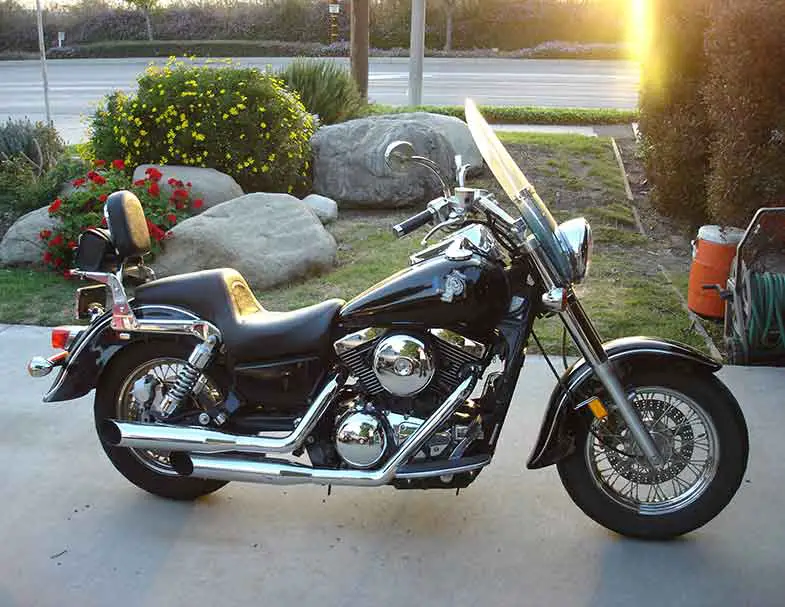
Tires & Brakes
Wire-spoke, chrome wheels are equipped with 130/90-16 M/C 67H front tires and 150/80-16 M/C 71H rear tires. Stock tires are tube-type and could either be Bridgestone Exedra G702/G703 or Dunlop D404FU/L rubber. Recommended front and rear tire pressures are 200 kPa (2.0 kgf/cm2, 28 psi) and 280 kPa (2.8 kgf/cm2, 40 psi), respectively.
You can change stock rubber to Dunlop American Elite Whitewall Front Tires (view on Amazon) – great for touring applications. However, it would be different if you have a Mean Streak, as it has 17-inch rims and requires 130/70 R17M/C (62H) front and 170/60 R17 M/C (72H) rear tires (view on Amazon).
As for brakes, single-action 270-/300-mm front and rear discs with dual-piston calipers provide the Classic FI stopping power. Many riding enthusiasts found this brake system lacking, which prompted Kawasaki to upgrade to double 280-mm discs with dual-piston calipers starting with the Tourer/Nomad models. Out of all Vulcan 1500s, the Mean Streak received the best brake system with 320-mm dual discs and six-piston calipers.
Suspension
The Kawasaki Vulcan 1500 has a wheelbase of 1,655 to 1,705 mm (65.2 to 67.1 inches). Minimum ground clearance is 125 mm (4.9 inches) on the Classic FI and 135 mm (5.31 inches) on the Tourer/Nomad. Rake is 32° on the fuel-injected Classic, while trail differs per model and is between 123 mm (4.84 inches) and 165 mm (6.5 inches).
Changes to the chassis began with the Classic FI model, which received larger-diameter main tubes, farther-spaced front legs, and damper-rod internals – to name a few. Essentially, it combined elements from the Classic, Drifter, and Nomad frames. And as a result, the cruiser’s wallowing in fast corners diminished, and overall handling improved.
Most Vulcan 1500 bikes (except for the Mean Streak) have 41-mm hydraulic telescopic forks. At the back, they have a swingarm and air-/rebound-damping-adjustable twin shocks. Wheel travel offered is 150 mm (5.9 inches) at the front and a range of 87 to 100 mm (3.4 to 3.9 inches) at the back, depending on trim and year.
Dimensions
Overall dimensions have very little difference between VN1500 models. The Kawasaki Vulcan Classic 1500 FI measures 2,505 x 995 x 1,140 mm (98.6 x 39.2 x 44.9 inches). Meanwhile, the rest of the trims’ dimensions are within ± 2% of these measurements.
The Drifter is the longest at 2,545 mm (100 inches), the Classic FI is the widest, and the Tourer or Nomad bikes are the tallest at 1,430 mm (56.3 inches). Conversely, the Mean Streak has the shortest length at 2,410 mm (94.9 inches) and is the narrowest at 850 mm (33.5 inches).
Seat height is pretty decent and ranges between 700 mm (27.6 inches) and 730 mm (28.7 inches). While this perfectly suits medium to tall riders, those with 34-inch in-seams or longer may find the motorcycle uncomfortable, especially for all-day rides. Thankfully, the cushioned two-seater saddle helps offset this flaw.
In terms of stock dry weight, the Mean Streak is the lightest at 289 Kg (637 lbs.), followed by the carbureted Classic. The Tourer/Nomad FI trims are the heaviest at 337 Kg (743 lbs.) and share the same weight as the Classic models released in California.
Exterior
It has a tubular, double-cradle steel frame (with a 32° caster angle and a 165-mm/6.5-inch trail) that houses the engine and drivetrain components. Standard inclusions are handlebars, grips, chain/fork guards, a windshield, headlamps, front/rear fenders, and side mirrors. Styling differences were only noticeable with the seat, fenders, and body panels – the rest were close to negligible.
Tourer models (marketed as Nomad in the U.S.) looked somewhat like old-school BMW GS R1150s with their enclosing rear fenders and tall windshield – but with less prominent fuel tanks. Drifter models had slightly smaller fenders and a restyled seat. However, the fenders were still overkill (covering almost half the size of the front and rear tires) compared to those on present-day cruisers.
Out of all the trims launched under the Vulcan 1500 series, the Mean Streak had the most polished look. The said trim did away with the windshield and excessive fenders, reshaped the saddle to support an up-to-tank design and was essentially the closest thing to a showroom bobber. Unfortunately, it was only made available to the public for two years.

Kawasaki Vulcan 1500 Price
From 1987 to 2008, the Kawasaki Vulcan 1500 series released 11 models and 21 trims in Japan, Europe, and North America. Here is a full rundown of the Vulcan 1500 trims and their corresponding prices:
Kawasaki Vulcan 88
| Year – Trim – Model Number | List Price | Retail/Trade-In Values |
|---|---|---|
| 1987 – 1988 Kawasaki VN1500-A1/A2 | $5,899 – $6,199 | $470 – $3,525 |
| 1989 – 1990 Kawasaki VN1500-A3/A4 | $6,299 – $6,499 | $495 – $3,850 |
| 1991 – 1993 Kawasaki VN1500-A5 to A7 | $6,599 – $6,999 | $530 – $5,145 |
| 1994 – 1997 Kawasaki VN1500-A8 to A11 | $7,699 – $8,599 | $635 – $5,440 |
| 1998 – 1999 Kawasaki VN1500-A12/A13 | $7,999 | $605 – $4,560 |
Kawasaki Vulcan 1500 Limited
| Year – Trim – Model Number | List Price | Retail/Trade-In Values |
|---|---|---|
| 1988 Kawasaki VN1500-B2 (Vulcan 88 SE) | $6,199 | $470 – $3,525 |
| 1990 Kawasaki VN1500-B4 (Vulcan 88 SE) | $6,399 | $495 – $3,850 |
| 1996 – 1997 Kawasaki Vulcan 1500-C3/C4 | $6,999 – $8,799 | $535 – $4,290 |
| 2006 Kawasaki VN1500-T6F (10th Anniversary Edition) | $9,799 | N/A |
Kawasaki Vulcan 1500 Classic (Carbureted)
| Year – Trim – Model Number | List Price | Retail/Trade-In Values |
|---|---|---|
| 1996 Kawasaki Vulcan 1500-D1 | $10,499 | $650 – $5,330 |
| 1997 Kawasaki VN1500-D2/D2A | $10,699 | $730 – $5,155 |
| 1998 Kawasaki VN1500-E1/F1 | $10,299 | $815 – $5,340 |
| 1999 Kawasaki VN1500-E2/F2 | $9,999 | $825 – $5,365 |
| 2000 – 2004 Kawasaki VN1500-E3 to E7 | $8,999 – $9,999 | $930 – $5,895 |
Kawasaki Vulcan 1500 Classic FI
| Year – Trim – Model Number | List Price | Retail/Trade-In Values |
|---|---|---|
| 2000 – 2003 Kawasaki VN1500-N1 to N4 | $10,599 – $10,799 | $935 – $5,450 |
| 2006 Kawasaki VN1500-N6F | $9,599 | $2,905 – $3,825 |
| 2007 – 2008 Kawasaki VN1500-N7F/N8F | $9,699 | $2,970 – $4,295 |
Kawasaki Vulcan 1500 Tourer / Nomad (Carbureted)
| Year – Trim – Model Number | List Price | Retail/Trade-In Values |
|---|---|---|
| 1998 – 1999 Kawasaki VN1500-G1/H1/G1A/G2/H2 | $11,999 | $870 – $5,490 |
| 2000 Kawasaki Vulcan 1500-G2A | $12,299 | $935 – $5,480 |
| 2001 Kawasaki VN1500-G3 | $12,299 | $1,130 – $5,600 |
Kawasaki Vulcan 1500 Tourer / Nomad FI
| Year – Trim – Model Number | List Price | Retail/Trade-In Values |
|---|---|---|
| 2000 Kawasaki VN1500-L1/L1H | $12,799 | $940 – $5,485 |
| 2001 – 2004 Kawasaki VN1500-L2 to L5/L2H to L4H | $12,999 | $1,160 – $5,755 |
Kawasaki Vulcan 1500 Drifter (Fuel-injected)
| Year – Trim – Model Number | List Price | Retail/Trade-In Values |
|---|---|---|
| 1999 – 2000 Kawasaki Vulcan 1500-J1/J2 | $11,499 | $845 – $5,655 |
| 2001 – 2005 Kawasaki Vulcan 1500-R1 to R5 | $10,999 – $11,799 | $1,090 – $5,700 |
Kawasaki Vulcan 1500 Mean Streak (Fuel-injected)
| Year – Trim – Model Number | List Price | Retail/Trade-In Values |
|---|---|---|
| 2002 Kawasaki Vulcan 1500-P1/P1H | $10,999 | $2,550 – $3,355 |
| 2003 Kawasaki VN1500-P2/P2H | $10,999 | $2,685 – $3,535 |
Depending on model year and trim, the cruiser bikes were either carbureted or fuel-injected. 2003 proved to be the busiest year for the Kawasaki Vulcan 1500 series. But even then, only the FI versions of all the Vulcan models were available in the market. The Kawasaki VN1500 Mean Streak was taken out of the roster by the end of the same year, leaving the Classic, Tourer, and Drifter models to continue sales in North America from 2004 until 2008.
The Kawasaki Vulcan 88
Although better known by consumers and most riding enthusiasts, the above trims do not encompass all production models. The fire-starter for the Vulcan 1500 series was the Kawasaki Vulcan 88. According to knowing motorheads, it started all the rage for Kawasaki cruisers. The bike, produced from 1987 to 1999, sported a 1,464-cc engine displacement and a liquid-cooled V-twin design.
It may look like an oversized Vulcan 750, but it offers superb handling and even bests some Victory and Crotch Rocket cruisers on performance. Repair parts like brakes, clutches and water pumps are easy to find (however, the reverse is true for accessories). On the downside, the Vulcan 88 has one major flaw. It tends to grow a bit noisier at speeds of 80 mph or more. Fortunately, you can resolve this issue by equipping the bike with compatible hard-chrome pipes and a Cobra airbox removal kit.
Kawasaki Vulcan 1500 Problems
Despite its bulletproof, unstoppable nature, the Kawasaki Vulcan 1500 is not without problems. Here are the most common issues pointed out by mechanics and enthusiasts in publications and forums:
Oil Gear Failure
Common in pre-2005 Classic and Tourer/Nomad models, this issue was due to the plastic composition of the oil gear pump. Indications of the oil gear pump failure include engine noises (tapping), intermittent startup, whining sound (clutch area), CEL going off, and high oil pressure. Kawasaki later addressed the problem by upgrading the oil gear pump into metal for succeeding bikes from the Vulcan range.
Engine Noise
Stator failure produces noise that can be easy to confuse with a regular whining noise. However, engine noises indicating problems with the regulator/rectifier are distinct, as they are very high-pitched and seem to come from the left side of the power mill. Similarly, output shaft and bevel gear problems give off a rattling noise coming from the transmission.
Other than these two, riders also complain about the gearbox and maintenance of the bike. Some feel that FI trims feel a bit underpowered compared to carbureted ones. Furthermore, they have observed 4-speed trannies perform below par in long-distance rides versus 5-speed options.
Note that issues with the transmission, neutral finder, and kickstand switch are prevalent in smaller-displacement Vulcan installments. Sadly, they are mistaken for plaguing the 1,500-class bikes.
About Kawasaki
Kawasaki Heavy Industries is a Japanese industrial firm that has made a name for itself in the global automotive market. And like most exceptional companies, its history speaks of adaptability and growth. Originally a parts supplier for shipping businesses, Kawasaki evolved with the times – eventually withdrawing from the shipbuilding industry and diversifying its offerings to include bridges, aircraft, railroad cars, and (yes!) motorcycles like the Kawasaki Vulcan 1500.
Conclusion – Kawasaki Vulcan 1500 Review
The Kawasaki Vulcan 1500 has come a long way since its release in 1987. Its massive success has given birth to other displacements that are equally well-loved by loyal patrons. At present, the Vulcan series retains four (4) categories, namely – Vulcan 1700 Vaquero and Voyager, the Vulcan 900 Classic, Classic LT, and Custom, the Vulcan S, and the Vulcan S Café.
Fitted with newer tech and sport-oriented components, these models still embody the original ’40s styled cruiser. The continued reign of these spectacular machines on and off-road speaks volumes of the Vulcan 1500’s timeless functionality and design. More remarkably, they are a testament to Kawasaki’s foothold in the cruiser segment of the two-wheeler market.

